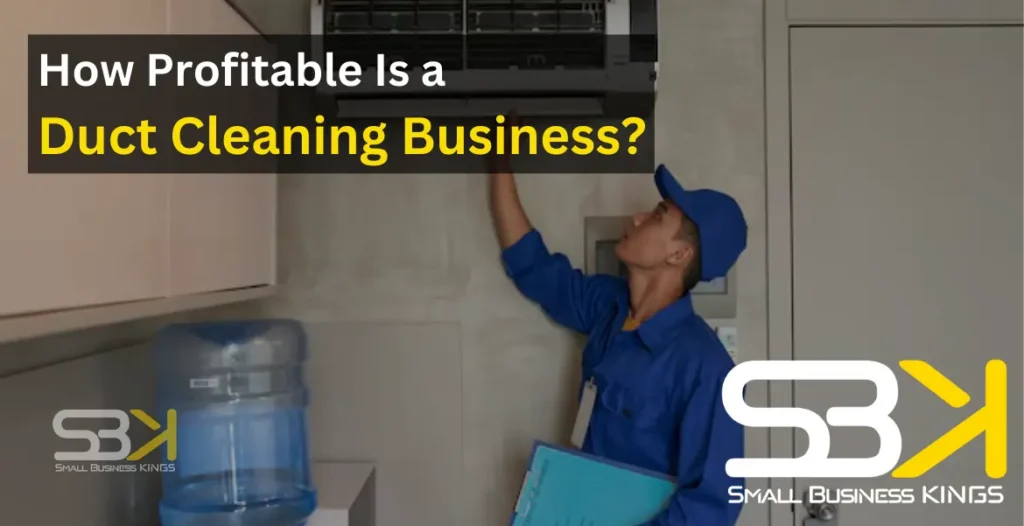Starting a duct cleaning business offers a promising opportunity for those looking to tap into an essential service that many homeowners and businesses rely on. However, understanding the potential profitability is critical before committing resources. The demand for duct cleaning services is growing due to increased awareness of indoor air quality, energy efficiency, and health concerns.
Additionally, with the right marketing strategies, operational efficiency, and customer service, duct cleaning businesses can achieve impressive profit margins. This article explores the various financial aspects, including startup costs, average earnings, factors that affect profitability, and how to scale your business effectively.
Whether you’re looking to start small or go big with specialized services, understanding the dynamics of the duct cleaning industry will help set you up for success. Let’s dive deeper into how you can assess and maximize the profitability of your duct cleaning business.
Market Overview for Duct Cleaning Business
The duct cleaning industry is growing steadily, fueled by increasing awareness of indoor air quality and energy efficiency. As demand for these services continues to rise, businesses in this sector have profitable opportunities.
Current Trends in the Duct Cleaning Market
The duct cleaning industry has seen a steady rise in demand, driven by several factors, including increased awareness of health and energy efficiency. As homeowners and businesses become more conscious of indoor air quality, the need for professional duct cleaning services has grown.
In addition to residential properties, commercial establishments such as offices, retail stores, and hospitals also require regular duct cleaning to maintain air quality and ensure compliance with building regulations. These trends indicate that the duct cleaning market is on the upswing, with projected revenue reaching $1.1 billion in 2025 (Source: IBISWorld, 2025).
Projected Growth and Market Size Statistics
Market research indicates a growing demand for duct cleaning services. As more people become aware of the importance of clean air ducts for health and energy savings, the industry is expected to continue expanding. This presents a lucrative opportunity for entrepreneurs looking to enter the business.
Potential Earnings
When setting up a bank account for your LLC, several legal requirements must be met to ensure compliance and smooth operation:
- State Requirements: While federal law doesn’t mandate a separate bank account, some states may have specific regulations or recommendations. It’s important to check with your state’s business registration office or a legal advisor to ensure you meet any local requirements.
- Federal Guidelines: The IRS and federal guidelines encourage keeping business finances separate to maintain the LLC’s legal protections and simplify tax reporting. This separation helps uphold the integrity of your LLC and avoids potential legal complications.
- Required Documentation: To open a business bank account, you’ll typically need to provide:
- EIN (Employer Identification Number): Issued by the IRS, this number is necessary for tax reporting and opening a business account.
- LLC Operating Agreement: This document outlines the management structure and operational procedures of your LLC.
- Business License: A valid license shows that your business is legally authorized to operate.
Choosing the Right Bank for Your LLC
Breakdown of Average Earnings
The earning potential for duct cleaning business owners can vary depending on several factors, including service type, location, and expertise. On average, a well-established duct cleaning business can earn between $50,000 and $100,000 annually. However, the actual income depends on your ability to attract clients and manage the business effectively.
Typical Income Range
New duct cleaning businesses typically start with lower earnings but can grow over time. In the first year, income may be around $50,000, and as the business expands, earnings can reach $100,000 or more.
For a small team, monthly income can range from $3,000 to $8,000, totaling $36,000 to $96,000 annually. With commercial services like HVAC cleaning, monthly earnings can rise to $10,000 to $40,000, reaching $120,000 to $480,000 yearly.
This income may vary depending on factors like local demand, competition, the scope of services offered, and how well the business is managed. By managing operations effectively and diversifying services, duct cleaning businesses can achieve steady and profitable growth.
Variations Based on Service Type
Income can also vary depending on whether the business focuses on residential or commercial duct cleaning. While residential services might be more frequent, commercial jobs are often larger, more lucrative, and can lead to long-term contracts.
Impact of Specialized Services on Earnings
Adding specialized services such as dryer vent cleaning, air filtration, or UV light installation can significantly boost a duct cleaning business’s revenue. These services offer additional revenue streams, allowing business owners to cater to a broader market and increase their overall income.
Cost Considerations
Cost considerations are critical when evaluating and maintaining a business’s profitability. Effective cost management can help optimize profit margins, while overspending can lead to financial strain. Some of the key factors to consider when managing costs include:
Overview of Startup Costs
Starting a duct cleaning business requires an initial investment in equipment, marketing, and permits. Basic equipment, such as air compressors, vacuums, and cleaning brushes, can cost between $10,000 and $20,000. Additionally, marketing costs to establish an online presence and local advertising can range from $1,000 to $5,000.
Ongoing Operational Costs
Once the business is running, operational costs will include labor (if you hire employees), transportation, fuel, and supplies. Depending on the scale of your business, operational costs can range from $30,000 to $60,000 annually.
Profitability of a Duct Cleaning Business
Profit margins in the duct cleaning industry typically range from 15% to 35%, which directly impacts operational profit. Operational profit can be influenced by factors like effective cost management, pricing strategies, and the scope of services offered.
For example, residential duct cleaning services usually generate $3,000 to $8,000 per month, which makes up about 40% of the total revenue. This results in a gross profit that accounts for the cost of service delivery, such as labor and materials.
Expanding into commercial duct cleaning or offering specialized services like HVAC cleaning and mold remediation can increase monthly income, with commercial contracts ranging from $10,000 to $40,000. These contracts can account for up to 50% of total revenue, significantly improving gross profit. Furthermore, eco-friendly solutions can boost profitability by adding around 10% to the overall income, thus impacting net profit as well.
By implementing smart marketing strategies, ensuring high customer retention, and managing operational costs efficiently, duct cleaning businesses can enhance both their operational and net profits. With consistent effort, these businesses can achieve strong and sustainable profitability.
How to Calculate Profits for a Duct Cleaning Business?
Calculating profits is crucial to understanding the financial performance of your duct cleaning business. Here’s a simplified breakdown:
1. Operating Profit
Operating profit measures the earnings you make from providing duct cleaning services after accounting for operational costs.
Operating Profit = Revenue – Operating Expenses
Example:
If your revenue from duct cleaning services is $12,000 and operating expenses (e.g., employee wages, cleaning supplies) are $8,000, your operating profit is $4,000.
2. Gross Profit
Gross profit shows how much you make after covering the direct costs of performing duct cleaning services, such as labor and materials.
Gross Profit = Revenue – Cost of Goods Sold (COGS)
Example:
If your revenue from duct cleaning is $12,000 and your direct costs (e.g., cleaning materials, technician labor) total $5,000, your gross profit is $7,000.
3. Net Profit
Net profit is the final profit after subtracting all business expenses, including taxes, interest, and overhead costs. It reflects the true financial outcome of your business.
Net Profit = Gross Profit – Operating Expenses – Taxes – Interest
Example:
If your gross profit is $7,000 and after deducting operating costs, taxes, and interest amounting to $3,500, your net profit would be $3,500.
By calculating these profits, you can gauge the financial health of your duct cleaning business and make strategic decisions to improve profitability.
Factors Influencing Profitability
Profitability is influenced by a wide range of factors that can either enhance or hinder a business’s ability to generate income. Understanding these factors is crucial for optimizing performance and ensuring long-term success. Some of the key factors that affect profitability include:
Geographic Location's Impact on Earnings
Location plays a significant role in the profitability of a duct cleaning business. Urban areas with high populations and commercial properties tend to offer more opportunities, while rural areas may have lower demand. Your business’s success will depend on the local demand for duct cleaning services.
Seasonal Demand Fluctuations
Demand for duct cleaning services can fluctuate throughout the year, with certain seasons being more profitable than others. For example, colder months may see an uptick in demand as people prepare their heating systems, while the summer may have a slower pace. Understanding seasonal trends and adjusting your marketing efforts accordingly can help maintain a steady income.
Competition
The level of competition in your area plays a key role in profitability. In regions with numerous service providers, you may need to lower your rates or invest more in marketing and promotions to stand out. While these efforts can attract customers, they may also eat into your profit margins, making it crucial to find a balance between competitive pricing and maintaining healthy margins.
Upsell Opportunities
Offering additional services during customer visits can significantly boost your revenue per job. For example, cleaning other areas like vents or HVAC systems alongside ducts can help increase your total earnings while reducing operating costs like fuel by completing multiple tasks in one trip.
Reputation and Customer Service Impact
Word-of-mouth referrals and repeat business can play a major role in a duct cleaning business’s profitability. Providing excellent customer service and maintaining a good reputation in your local community is vital for long-term success.
Marketing Strategies for Increasing Profitability
Creating a strong online presence is key to drawing in new clients. A professional website and active social media profiles can help establish credibility. Local advertising through flyers, direct mail, and community events can also drive traffic to your business.
Forming partnerships with HVAC companies and other related industries can help expand your customer base. These partnerships can lead to referrals, allowing both businesses to benefit from each other’s client networks.
Keeping your existing customers is just as crucial as bringing in new ones. Offering loyalty programs, follow-up calls, or discounts on future services can encourage repeat business and positive reviews, boosting profitability.
Is Duct Cleaning a Good Business to Start?
Duct cleaning is a profitable business, driven by increasing awareness of air quality and HVAC maintenance. As more people recognize the health benefits of clean air ducts, demand continues to grow.
With low startup costs and the potential for repeat customers, it’s an attractive option. Offering high-quality service and upselling related services, like air purification or HVAC repairs, can further boost profitability. Overall, duct cleaning is a strong business choice with good profitability potential when managed efficiently and with a focus on customer satisfaction.
Challenges and Risks
Some of the challenges in this industry include stiff competition, fluctuating demand, and market saturation. As the business grows, you may also face staffing issues, increasing operational costs, and managing customer expectations.
Liability issues, such as property damage or accidents during cleaning, are a potential risk. Additionally, expensive equipment can be prone to wear and tear, leading to high repair or replacement costs.
Case Studies or Examples
COIT Cleaning and Restoration Services: COIT is a well-known national brand that offers a variety of services, including air duct cleaning. By providing high-quality service and diversifying their offerings (carpet cleaning, water damage restoration, etc.), COIT has grown into a large franchise network. They’ve successfully marketed their services by focusing on customer satisfaction, offering warranty programs, and maintaining a strong online presence. This approach has helped them scale and generate substantial revenue.
Air Duct Cleaning USA: Based in California, Air Duct Cleaning USA has become a leader in both residential and commercial duct cleaning services. They specialize in providing eco-friendly services, which has helped attract environmentally-conscious customers. The company’s focus on customer education, transparency in pricing, and high-quality service has allowed them to build a loyal customer base, leading to continued growth.
These examples demonstrate that duct cleaning businesses can find success through diversification, quality service, and targeted marketing strategies, regardless of whether they serve residential, commercial, or specialized markets. Each of these companies has tailored their approach to meet the needs of their target customer, and their business models show the importance of customer retention, consistent service, and adaptability to market demands.
Conclusion
In conclusion, the duct cleaning industry offers a solid opportunity for entrepreneurs looking to start their own business. With the potential for significant earnings through specialized services, the profitability of a duct cleaning business can be substantial.
However, success depends on various factors, including location, marketing strategies, and the ability to manage operational costs. By staying informed about industry trends and maintaining a focus on customer service, you can build a profitable duct cleaning business with sustainable growth.
FAQs
- What’s the startup cost for a duct cleaning business?
The average startup cost ranges from $10,000 to $25,000, depending on the equipment and marketing efforts. - How much can I earn from a duct cleaning business?
Most duct cleaning business owners earn between $50,000 to $100,000 annually, with potential for higher earnings depending on service type and market. - What factors affect duct cleaning profitability?
Key factors include geographic location, seasonal demand, reputation, and the types of services offered. - What’s better: residential or commercial duct cleaning?
Commercial duct cleaning can be more profitable, but residential cleaning is typically more frequent. Combining both can balance revenue. - What are top marketing strategies for duct cleaning?
Effective strategies include building an online presence, local advertising, forming partnerships with HVAC companies, and offering customer retention programs.




